Unit 32: Business Strategy Report - Nike's Internal Analysis
VerifiedAdded on 2021/10/04
|18
|5482
|46
Report
AI Summary
This report provides a detailed analysis of Nike's business strategy, focusing on internal factors that influence its performance. It begins by defining strategic capabilities and then delves into a comprehensive value chain analysis using Porter's model to identify primary and support activities within Nike, highlighting both strengths and weaknesses. The VRIO framework is then applied to assess Nike's resources and capabilities in terms of value, rarity, imitability, and organization. Furthermore, the report incorporates benchmarking techniques to compare Nike's performance with competitors in the sportswear industry. A SWOT analysis is conducted to summarize Nike's strengths and weaknesses. The report concludes with an overall evaluation of Nike's strategic position, drawing on the analysis of internal factors and providing insights into its competitive advantages and areas for improvement.
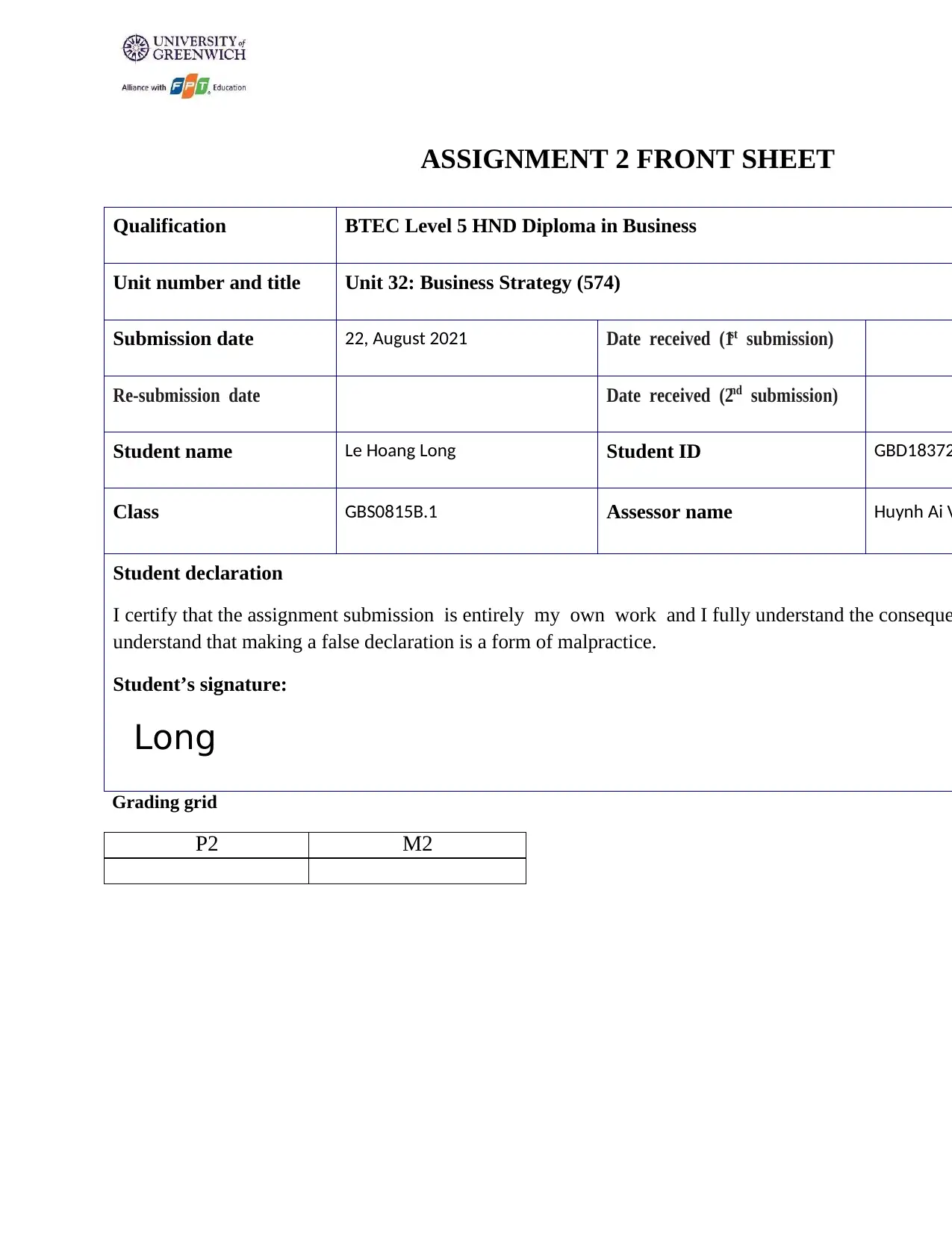
ASSIGNMENT 2 FRONT SHEET
Qualification BTEC Level 5 HND Diploma in Business
Unit number and title Unit 32: Business Strategy (574)
Submission date 22, August 2021 Date received (1st submission)
Re-submission date Date received (2nd submission)
Student name Le Hoang Long Student ID GBD18372
Class GBS0815B.1 Assessor name Huynh Ai V
Student declaration
I certify that the assignment submission is entirely my own work and I fully understand the conseque
understand that making a false declaration is a form of malpractice.
Student’s signature:
Long
Grading grid
P2 M2
Qualification BTEC Level 5 HND Diploma in Business
Unit number and title Unit 32: Business Strategy (574)
Submission date 22, August 2021 Date received (1st submission)
Re-submission date Date received (2nd submission)
Student name Le Hoang Long Student ID GBD18372
Class GBS0815B.1 Assessor name Huynh Ai V
Student declaration
I certify that the assignment submission is entirely my own work and I fully understand the conseque
understand that making a false declaration is a form of malpractice.
Student’s signature:
Long
Grading grid
P2 M2
Paraphrase This Document
Need a fresh take? Get an instant paraphrase of this document with our AI Paraphraser
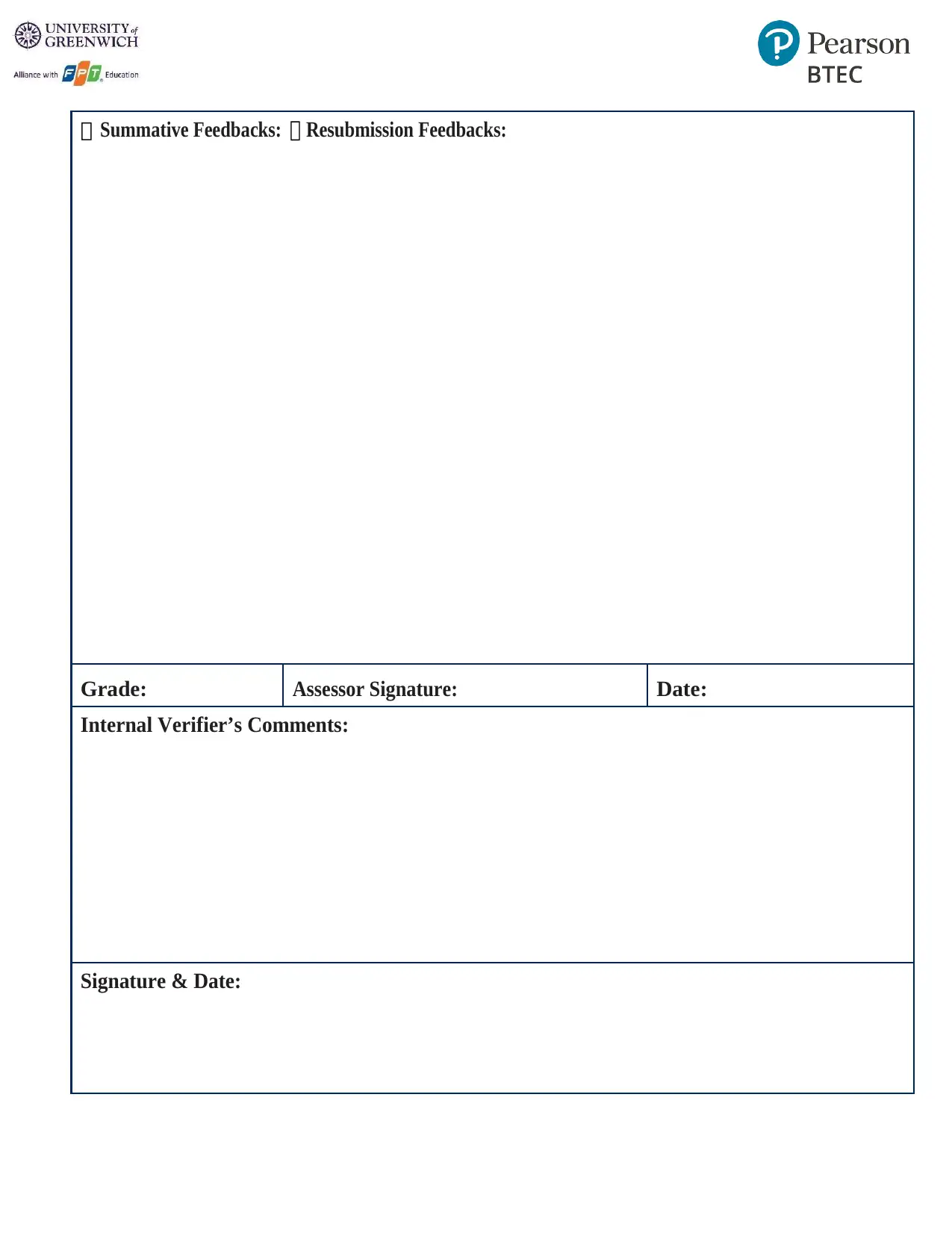
Summative Feedbacks: Resubmission Feedbacks:
Grade: Assessor Signature: Date:
Internal Verifier’s Comments:
Signature & Date:
Grade: Assessor Signature: Date:
Internal Verifier’s Comments:
Signature & Date:
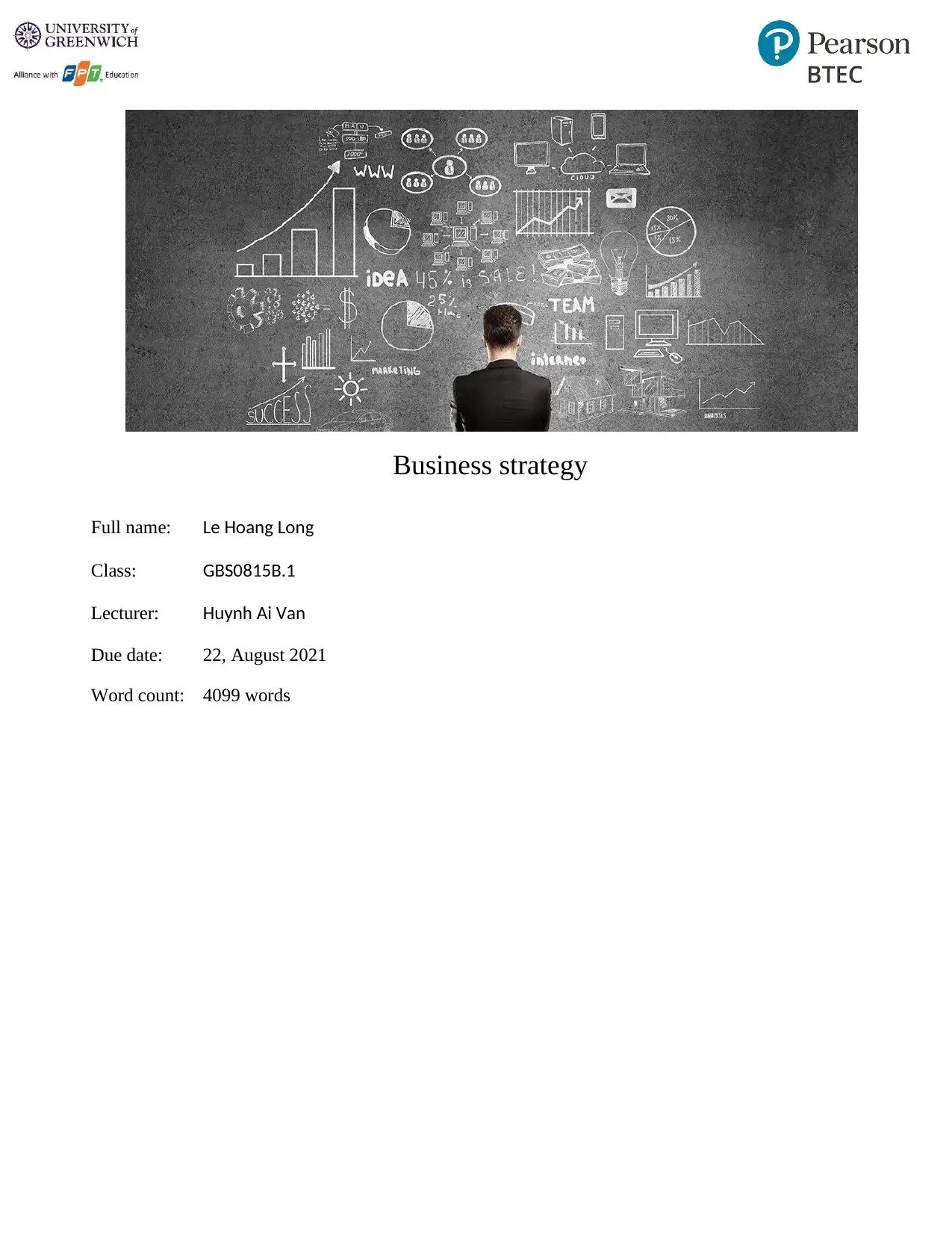
Business strategy
Full name: Le Hoang Long
Class: GBS0815B.1
Lecturer: Huynh Ai Van
Due date: 22, August 2021
Word count: 4099 words
Full name: Le Hoang Long
Class: GBS0815B.1
Lecturer: Huynh Ai Van
Due date: 22, August 2021
Word count: 4099 words
⊘ This is a preview!⊘
Do you want full access?
Subscribe today to unlock all pages.

Trusted by 1+ million students worldwide
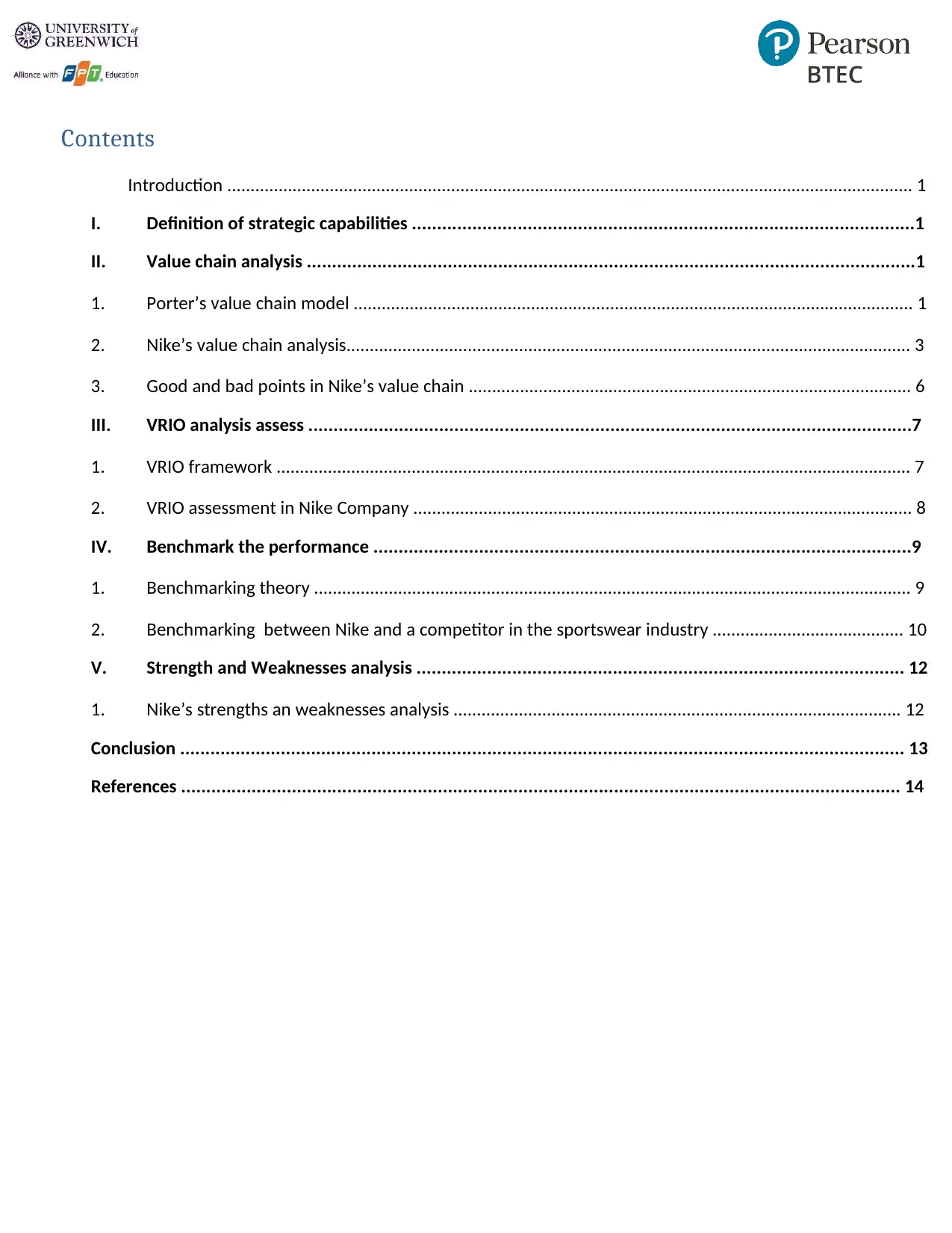
Contents
Introduction ................................................................................................................................................... 1
I. Definition of strategic capabilities ....................................................................................................1
II. Value chain analysis .........................................................................................................................1
1. Porter’s value chain model ........................................................................................................................ 1
2. Nike’s value chain analysis......................................................................................................................... 3
3. Good and bad points in Nike’s value chain ............................................................................................... 6
III. VRIO analysis assess ........................................................................................................................7
1. VRIO framework ........................................................................................................................................ 7
2. VRIO assessment in Nike Company ........................................................................................................... 8
IV. Benchmark the performance ...........................................................................................................9
1. Benchmarking theory ................................................................................................................................ 9
2. Benchmarking between Nike and a competitor in the sportswear industry ......................................... 10
V. Strength and Weaknesses analysis ................................................................................................. 12
1. Nike’s strengths an weaknesses analysis ................................................................................................ 12
Conclusion ................................................................................................................................................ 13
References ............................................................................................................................................... 14
Introduction ................................................................................................................................................... 1
I. Definition of strategic capabilities ....................................................................................................1
II. Value chain analysis .........................................................................................................................1
1. Porter’s value chain model ........................................................................................................................ 1
2. Nike’s value chain analysis......................................................................................................................... 3
3. Good and bad points in Nike’s value chain ............................................................................................... 6
III. VRIO analysis assess ........................................................................................................................7
1. VRIO framework ........................................................................................................................................ 7
2. VRIO assessment in Nike Company ........................................................................................................... 8
IV. Benchmark the performance ...........................................................................................................9
1. Benchmarking theory ................................................................................................................................ 9
2. Benchmarking between Nike and a competitor in the sportswear industry ......................................... 10
V. Strength and Weaknesses analysis ................................................................................................. 12
1. Nike’s strengths an weaknesses analysis ................................................................................................ 12
Conclusion ................................................................................................................................................ 13
References ............................................................................................................................................... 14
Paraphrase This Document
Need a fresh take? Get an instant paraphrase of this document with our AI Paraphraser
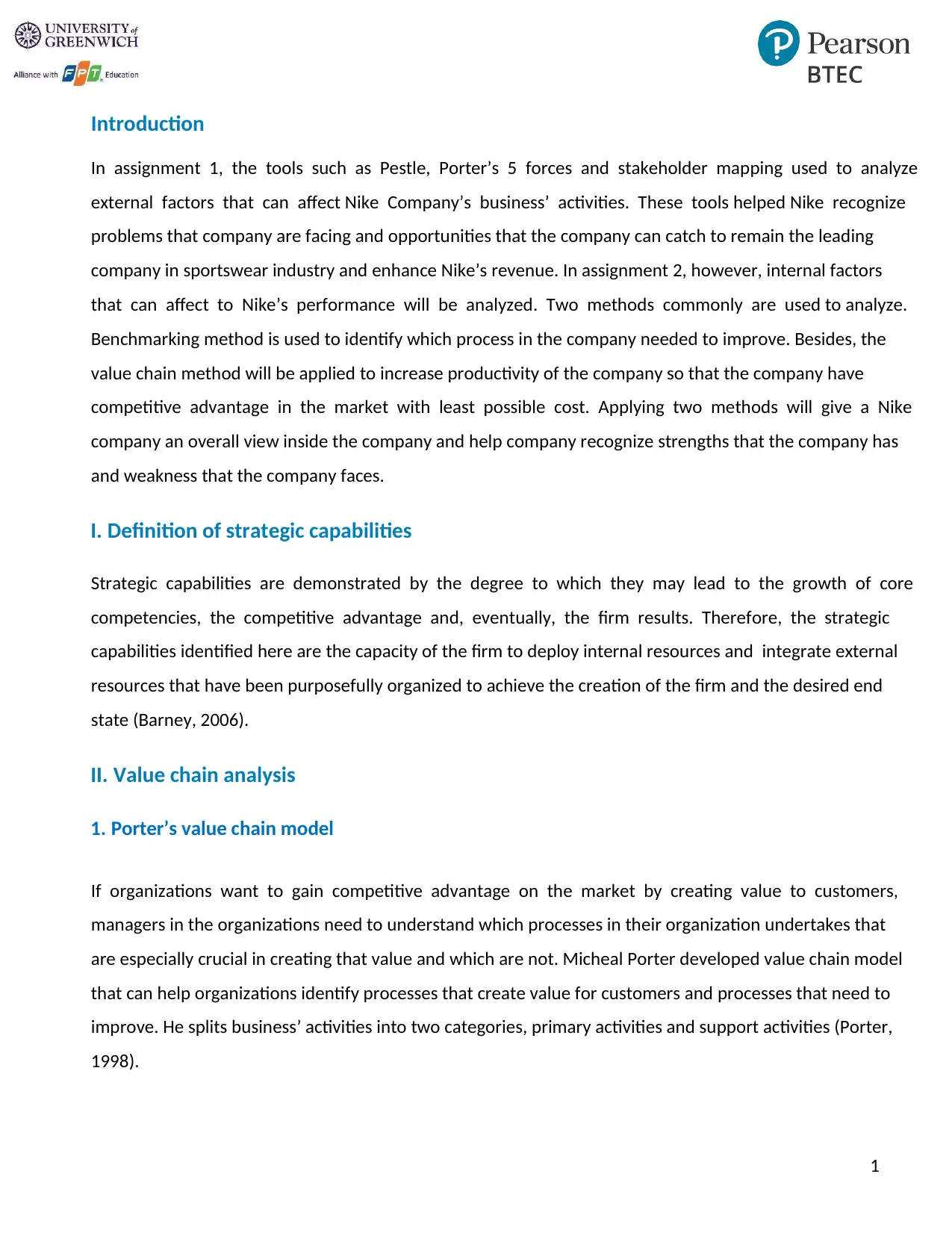
1
Introduction
In assignment 1, the tools such as Pestle, Porter’s 5 forces and stakeholder mapping used to analyze
external factors that can affect Nike Company’s business’ activities. These tools helped Nike recognize
problems that company are facing and opportunities that the company can catch to remain the leading
company in sportswear industry and enhance Nike’s revenue. In assignment 2, however, internal factors
that can affect to Nike’s performance will be analyzed. Two methods commonly are used to analyze.
Benchmarking method is used to identify which process in the company needed to improve. Besides, the
value chain method will be applied to increase productivity of the company so that the company have
competitive advantage in the market with least possible cost. Applying two methods will give a Nike
company an overall view inside the company and help company recognize strengths that the company has
and weakness that the company faces.
I. Definition of strategic capabilities
Strategic capabilities are demonstrated by the degree to which they may lead to the growth of core
competencies, the competitive advantage and, eventually, the firm results. Therefore, the strategic
capabilities identified here are the capacity of the firm to deploy internal resources and integrate external
resources that have been purposefully organized to achieve the creation of the firm and the desired end
state (Barney, 2006).
II. Value chain analysis
1. Porter’s value chain model
If organizations want to gain competitive advantage on the market by creating value to customers,
managers in the organizations need to understand which processes in their organization undertakes that
are especially crucial in creating that value and which are not. Micheal Porter developed value chain model
that can help organizations identify processes that create value for customers and processes that need to
improve. He splits business’ activities into two categories, primary activities and support activities (Porter,
1998).
Introduction
In assignment 1, the tools such as Pestle, Porter’s 5 forces and stakeholder mapping used to analyze
external factors that can affect Nike Company’s business’ activities. These tools helped Nike recognize
problems that company are facing and opportunities that the company can catch to remain the leading
company in sportswear industry and enhance Nike’s revenue. In assignment 2, however, internal factors
that can affect to Nike’s performance will be analyzed. Two methods commonly are used to analyze.
Benchmarking method is used to identify which process in the company needed to improve. Besides, the
value chain method will be applied to increase productivity of the company so that the company have
competitive advantage in the market with least possible cost. Applying two methods will give a Nike
company an overall view inside the company and help company recognize strengths that the company has
and weakness that the company faces.
I. Definition of strategic capabilities
Strategic capabilities are demonstrated by the degree to which they may lead to the growth of core
competencies, the competitive advantage and, eventually, the firm results. Therefore, the strategic
capabilities identified here are the capacity of the firm to deploy internal resources and integrate external
resources that have been purposefully organized to achieve the creation of the firm and the desired end
state (Barney, 2006).
II. Value chain analysis
1. Porter’s value chain model
If organizations want to gain competitive advantage on the market by creating value to customers,
managers in the organizations need to understand which processes in their organization undertakes that
are especially crucial in creating that value and which are not. Micheal Porter developed value chain model
that can help organizations identify processes that create value for customers and processes that need to
improve. He splits business’ activities into two categories, primary activities and support activities (Porter,
1998).
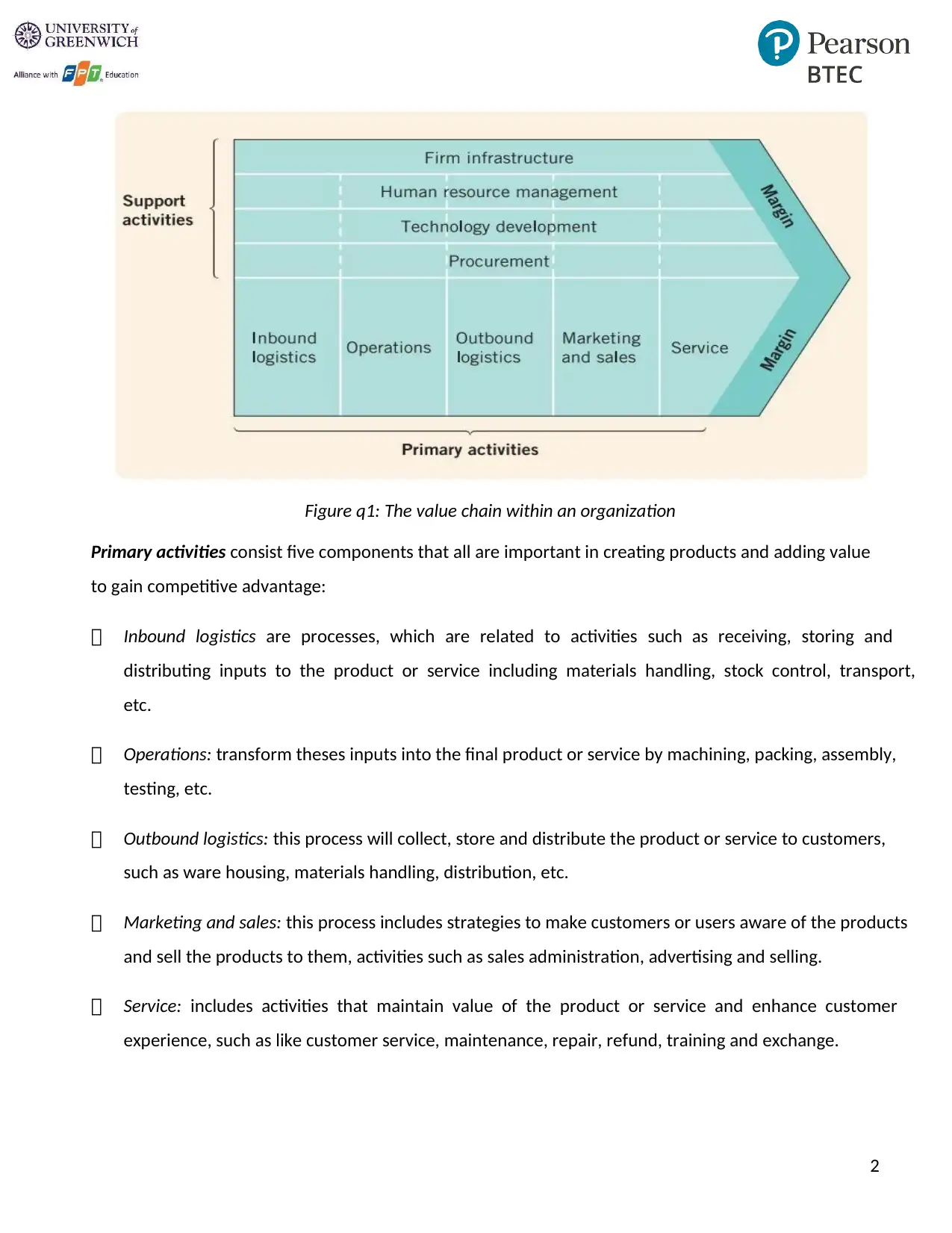
2
Figure q1: The value chain within an organization
Primary activities consist five components that all are important in creating products and adding value
to gain competitive advantage:
Inbound logistics are processes, which are related to activities such as receiving, storing and
distributing inputs to the product or service including materials handling, stock control, transport,
etc.
Operations: transform theses inputs into the final product or service by machining, packing, assembly,
testing, etc.
Outbound logistics: this process will collect, store and distribute the product or service to customers,
such as ware housing, materials handling, distribution, etc.
Marketing and sales: this process includes strategies to make customers or users aware of the products
and sell the products to them, activities such as sales administration, advertising and selling.
Service: includes activities that maintain value of the product or service and enhance customer
experience, such as like customer service, maintenance, repair, refund, training and exchange.
Figure q1: The value chain within an organization
Primary activities consist five components that all are important in creating products and adding value
to gain competitive advantage:
Inbound logistics are processes, which are related to activities such as receiving, storing and
distributing inputs to the product or service including materials handling, stock control, transport,
etc.
Operations: transform theses inputs into the final product or service by machining, packing, assembly,
testing, etc.
Outbound logistics: this process will collect, store and distribute the product or service to customers,
such as ware housing, materials handling, distribution, etc.
Marketing and sales: this process includes strategies to make customers or users aware of the products
and sell the products to them, activities such as sales administration, advertising and selling.
Service: includes activities that maintain value of the product or service and enhance customer
experience, such as like customer service, maintenance, repair, refund, training and exchange.
⊘ This is a preview!⊘
Do you want full access?
Subscribe today to unlock all pages.

Trusted by 1+ million students worldwide
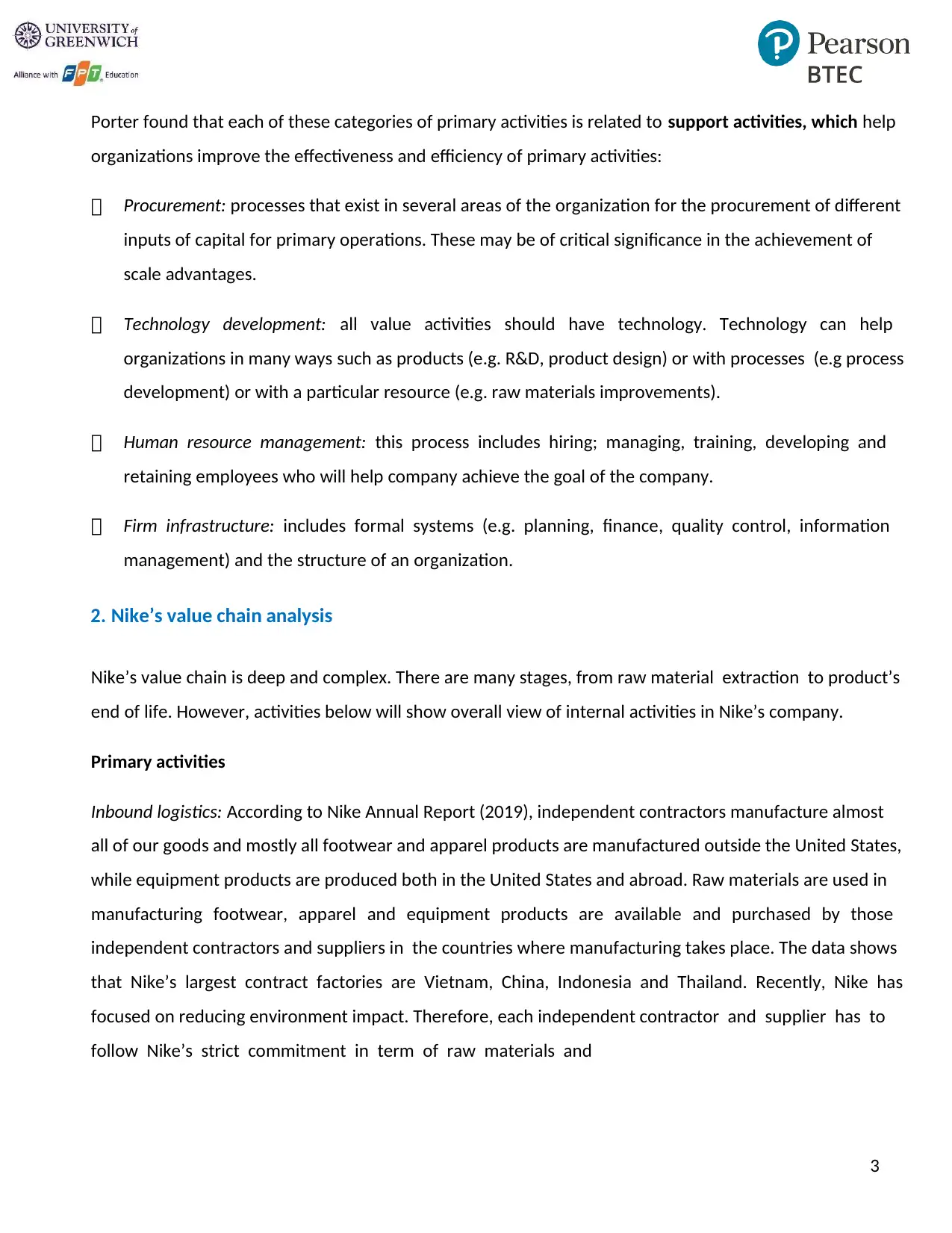
3
Porter found that each of these categories of primary activities is related to support activities, which help
organizations improve the effectiveness and efficiency of primary activities:
Procurement: processes that exist in several areas of the organization for the procurement of different
inputs of capital for primary operations. These may be of critical significance in the achievement of
scale advantages.
Technology development: all value activities should have technology. Technology can help
organizations in many ways such as products (e.g. R&D, product design) or with processes (e.g process
development) or with a particular resource (e.g. raw materials improvements).
Human resource management: this process includes hiring; managing, training, developing and
retaining employees who will help company achieve the goal of the company.
Firm infrastructure: includes formal systems (e.g. planning, finance, quality control, information
management) and the structure of an organization.
2. Nike’s value chain analysis
Nike’s value chain is deep and complex. There are many stages, from raw material extraction to product’s
end of life. However, activities below will show overall view of internal activities in Nike’s company.
Primary activities
Inbound logistics: According to Nike Annual Report (2019), independent contractors manufacture almost
all of our goods and mostly all footwear and apparel products are manufactured outside the United States,
while equipment products are produced both in the United States and abroad. Raw materials are used in
manufacturing footwear, apparel and equipment products are available and purchased by those
independent contractors and suppliers in the countries where manufacturing takes place. The data shows
that Nike’s largest contract factories are Vietnam, China, Indonesia and Thailand. Recently, Nike has
focused on reducing environment impact. Therefore, each independent contractor and supplier has to
follow Nike’s strict commitment in term of raw materials and
Porter found that each of these categories of primary activities is related to support activities, which help
organizations improve the effectiveness and efficiency of primary activities:
Procurement: processes that exist in several areas of the organization for the procurement of different
inputs of capital for primary operations. These may be of critical significance in the achievement of
scale advantages.
Technology development: all value activities should have technology. Technology can help
organizations in many ways such as products (e.g. R&D, product design) or with processes (e.g process
development) or with a particular resource (e.g. raw materials improvements).
Human resource management: this process includes hiring; managing, training, developing and
retaining employees who will help company achieve the goal of the company.
Firm infrastructure: includes formal systems (e.g. planning, finance, quality control, information
management) and the structure of an organization.
2. Nike’s value chain analysis
Nike’s value chain is deep and complex. There are many stages, from raw material extraction to product’s
end of life. However, activities below will show overall view of internal activities in Nike’s company.
Primary activities
Inbound logistics: According to Nike Annual Report (2019), independent contractors manufacture almost
all of our goods and mostly all footwear and apparel products are manufactured outside the United States,
while equipment products are produced both in the United States and abroad. Raw materials are used in
manufacturing footwear, apparel and equipment products are available and purchased by those
independent contractors and suppliers in the countries where manufacturing takes place. The data shows
that Nike’s largest contract factories are Vietnam, China, Indonesia and Thailand. Recently, Nike has
focused on reducing environment impact. Therefore, each independent contractor and supplier has to
follow Nike’s strict commitment in term of raw materials and
Paraphrase This Document
Need a fresh take? Get an instant paraphrase of this document with our AI Paraphraser
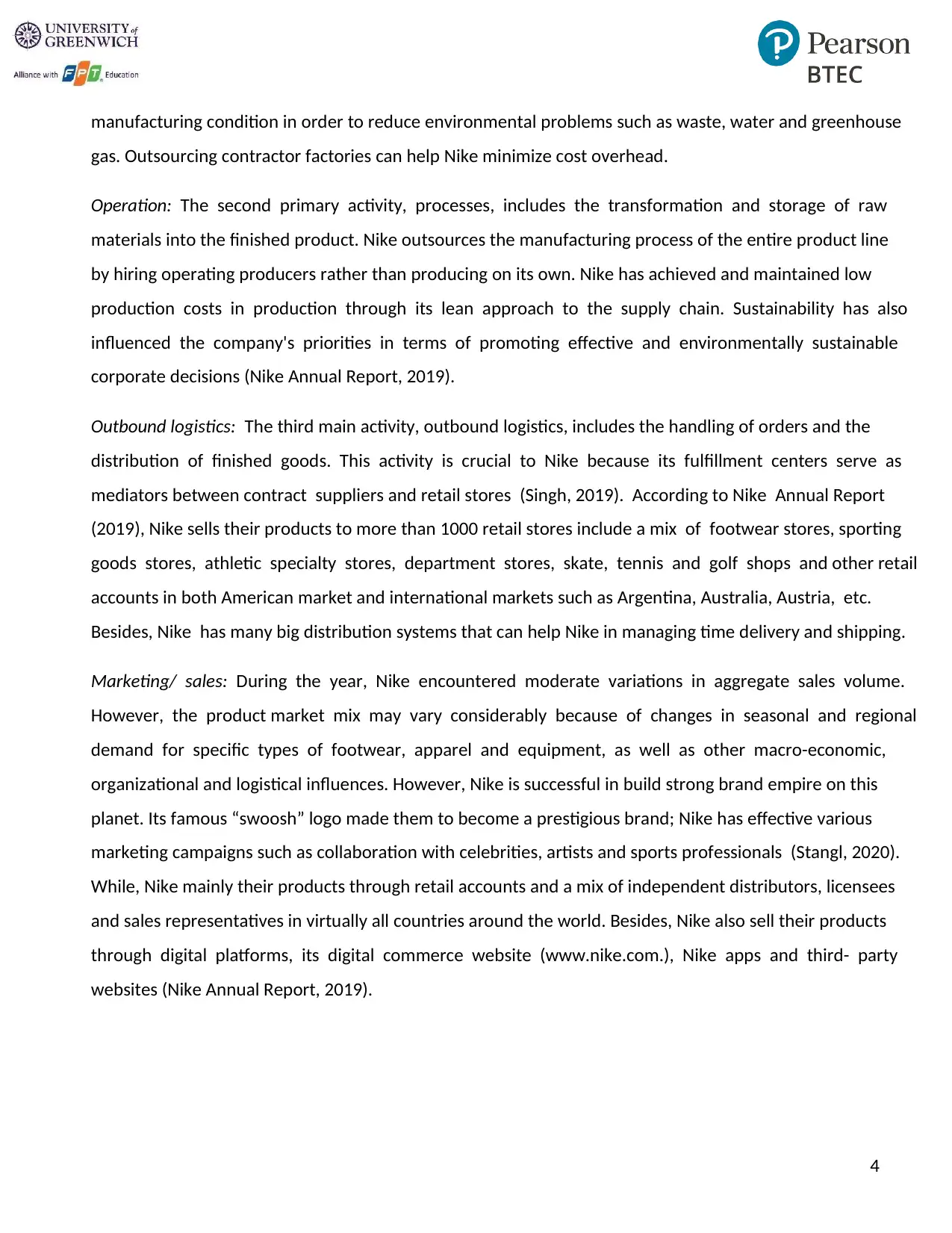
4
manufacturing condition in order to reduce environmental problems such as waste, water and greenhouse
gas. Outsourcing contractor factories can help Nike minimize cost overhead.
Operation: The second primary activity, processes, includes the transformation and storage of raw
materials into the finished product. Nike outsources the manufacturing process of the entire product line
by hiring operating producers rather than producing on its own. Nike has achieved and maintained low
production costs in production through its lean approach to the supply chain. Sustainability has also
influenced the company's priorities in terms of promoting effective and environmentally sustainable
corporate decisions (Nike Annual Report, 2019).
Outbound logistics: The third main activity, outbound logistics, includes the handling of orders and the
distribution of finished goods. This activity is crucial to Nike because its fulfillment centers serve as
mediators between contract suppliers and retail stores (Singh, 2019). According to Nike Annual Report
(2019), Nike sells their products to more than 1000 retail stores include a mix of footwear stores, sporting
goods stores, athletic specialty stores, department stores, skate, tennis and golf shops and other retail
accounts in both American market and international markets such as Argentina, Australia, Austria, etc.
Besides, Nike has many big distribution systems that can help Nike in managing time delivery and shipping.
Marketing/ sales: During the year, Nike encountered moderate variations in aggregate sales volume.
However, the product market mix may vary considerably because of changes in seasonal and regional
demand for specific types of footwear, apparel and equipment, as well as other macro-economic,
organizational and logistical influences. However, Nike is successful in build strong brand empire on this
planet. Its famous “swoosh” logo made them to become a prestigious brand; Nike has effective various
marketing campaigns such as collaboration with celebrities, artists and sports professionals (Stangl, 2020).
While, Nike mainly their products through retail accounts and a mix of independent distributors, licensees
and sales representatives in virtually all countries around the world. Besides, Nike also sell their products
through digital platforms, its digital commerce website (www.nike.com.), Nike apps and third- party
websites (Nike Annual Report, 2019).
manufacturing condition in order to reduce environmental problems such as waste, water and greenhouse
gas. Outsourcing contractor factories can help Nike minimize cost overhead.
Operation: The second primary activity, processes, includes the transformation and storage of raw
materials into the finished product. Nike outsources the manufacturing process of the entire product line
by hiring operating producers rather than producing on its own. Nike has achieved and maintained low
production costs in production through its lean approach to the supply chain. Sustainability has also
influenced the company's priorities in terms of promoting effective and environmentally sustainable
corporate decisions (Nike Annual Report, 2019).
Outbound logistics: The third main activity, outbound logistics, includes the handling of orders and the
distribution of finished goods. This activity is crucial to Nike because its fulfillment centers serve as
mediators between contract suppliers and retail stores (Singh, 2019). According to Nike Annual Report
(2019), Nike sells their products to more than 1000 retail stores include a mix of footwear stores, sporting
goods stores, athletic specialty stores, department stores, skate, tennis and golf shops and other retail
accounts in both American market and international markets such as Argentina, Australia, Austria, etc.
Besides, Nike has many big distribution systems that can help Nike in managing time delivery and shipping.
Marketing/ sales: During the year, Nike encountered moderate variations in aggregate sales volume.
However, the product market mix may vary considerably because of changes in seasonal and regional
demand for specific types of footwear, apparel and equipment, as well as other macro-economic,
organizational and logistical influences. However, Nike is successful in build strong brand empire on this
planet. Its famous “swoosh” logo made them to become a prestigious brand; Nike has effective various
marketing campaigns such as collaboration with celebrities, artists and sports professionals (Stangl, 2020).
While, Nike mainly their products through retail accounts and a mix of independent distributors, licensees
and sales representatives in virtually all countries around the world. Besides, Nike also sell their products
through digital platforms, its digital commerce website (www.nike.com.), Nike apps and third- party
websites (Nike Annual Report, 2019).
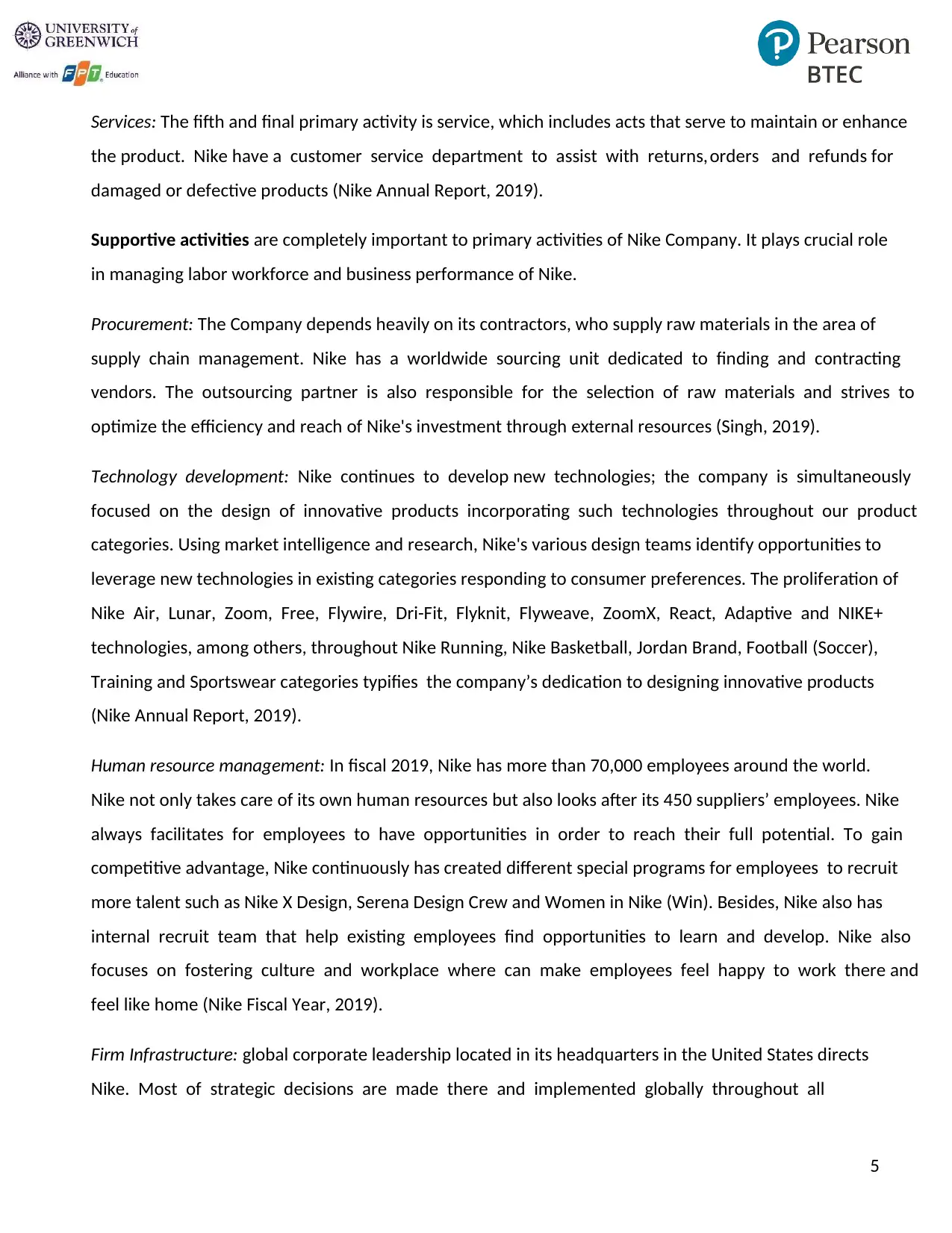
5
Services: The fifth and final primary activity is service, which includes acts that serve to maintain or enhance
the product. Nike have a customer service department to assist with returns, orders and refunds for
damaged or defective products (Nike Annual Report, 2019).
Supportive activities are completely important to primary activities of Nike Company. It plays crucial role
in managing labor workforce and business performance of Nike.
Procurement: The Company depends heavily on its contractors, who supply raw materials in the area of
supply chain management. Nike has a worldwide sourcing unit dedicated to finding and contracting
vendors. The outsourcing partner is also responsible for the selection of raw materials and strives to
optimize the efficiency and reach of Nike's investment through external resources (Singh, 2019).
Technology development: Nike continues to develop new technologies; the company is simultaneously
focused on the design of innovative products incorporating such technologies throughout our product
categories. Using market intelligence and research, Nike's various design teams identify opportunities to
leverage new technologies in existing categories responding to consumer preferences. The proliferation of
Nike Air, Lunar, Zoom, Free, Flywire, Dri-Fit, Flyknit, Flyweave, ZoomX, React, Adaptive and NIKE+
technologies, among others, throughout Nike Running, Nike Basketball, Jordan Brand, Football (Soccer),
Training and Sportswear categories typifies the company’s dedication to designing innovative products
(Nike Annual Report, 2019).
Human resource management: In fiscal 2019, Nike has more than 70,000 employees around the world.
Nike not only takes care of its own human resources but also looks after its 450 suppliers’ employees. Nike
always facilitates for employees to have opportunities in order to reach their full potential. To gain
competitive advantage, Nike continuously has created different special programs for employees to recruit
more talent such as Nike X Design, Serena Design Crew and Women in Nike (Win). Besides, Nike also has
internal recruit team that help existing employees find opportunities to learn and develop. Nike also
focuses on fostering culture and workplace where can make employees feel happy to work there and
feel like home (Nike Fiscal Year, 2019).
Firm Infrastructure: global corporate leadership located in its headquarters in the United States directs
Nike. Most of strategic decisions are made there and implemented globally throughout all
Services: The fifth and final primary activity is service, which includes acts that serve to maintain or enhance
the product. Nike have a customer service department to assist with returns, orders and refunds for
damaged or defective products (Nike Annual Report, 2019).
Supportive activities are completely important to primary activities of Nike Company. It plays crucial role
in managing labor workforce and business performance of Nike.
Procurement: The Company depends heavily on its contractors, who supply raw materials in the area of
supply chain management. Nike has a worldwide sourcing unit dedicated to finding and contracting
vendors. The outsourcing partner is also responsible for the selection of raw materials and strives to
optimize the efficiency and reach of Nike's investment through external resources (Singh, 2019).
Technology development: Nike continues to develop new technologies; the company is simultaneously
focused on the design of innovative products incorporating such technologies throughout our product
categories. Using market intelligence and research, Nike's various design teams identify opportunities to
leverage new technologies in existing categories responding to consumer preferences. The proliferation of
Nike Air, Lunar, Zoom, Free, Flywire, Dri-Fit, Flyknit, Flyweave, ZoomX, React, Adaptive and NIKE+
technologies, among others, throughout Nike Running, Nike Basketball, Jordan Brand, Football (Soccer),
Training and Sportswear categories typifies the company’s dedication to designing innovative products
(Nike Annual Report, 2019).
Human resource management: In fiscal 2019, Nike has more than 70,000 employees around the world.
Nike not only takes care of its own human resources but also looks after its 450 suppliers’ employees. Nike
always facilitates for employees to have opportunities in order to reach their full potential. To gain
competitive advantage, Nike continuously has created different special programs for employees to recruit
more talent such as Nike X Design, Serena Design Crew and Women in Nike (Win). Besides, Nike also has
internal recruit team that help existing employees find opportunities to learn and develop. Nike also
focuses on fostering culture and workplace where can make employees feel happy to work there and
feel like home (Nike Fiscal Year, 2019).
Firm Infrastructure: global corporate leadership located in its headquarters in the United States directs
Nike. Most of strategic decisions are made there and implemented globally throughout all
⊘ This is a preview!⊘
Do you want full access?
Subscribe today to unlock all pages.

Trusted by 1+ million students worldwide
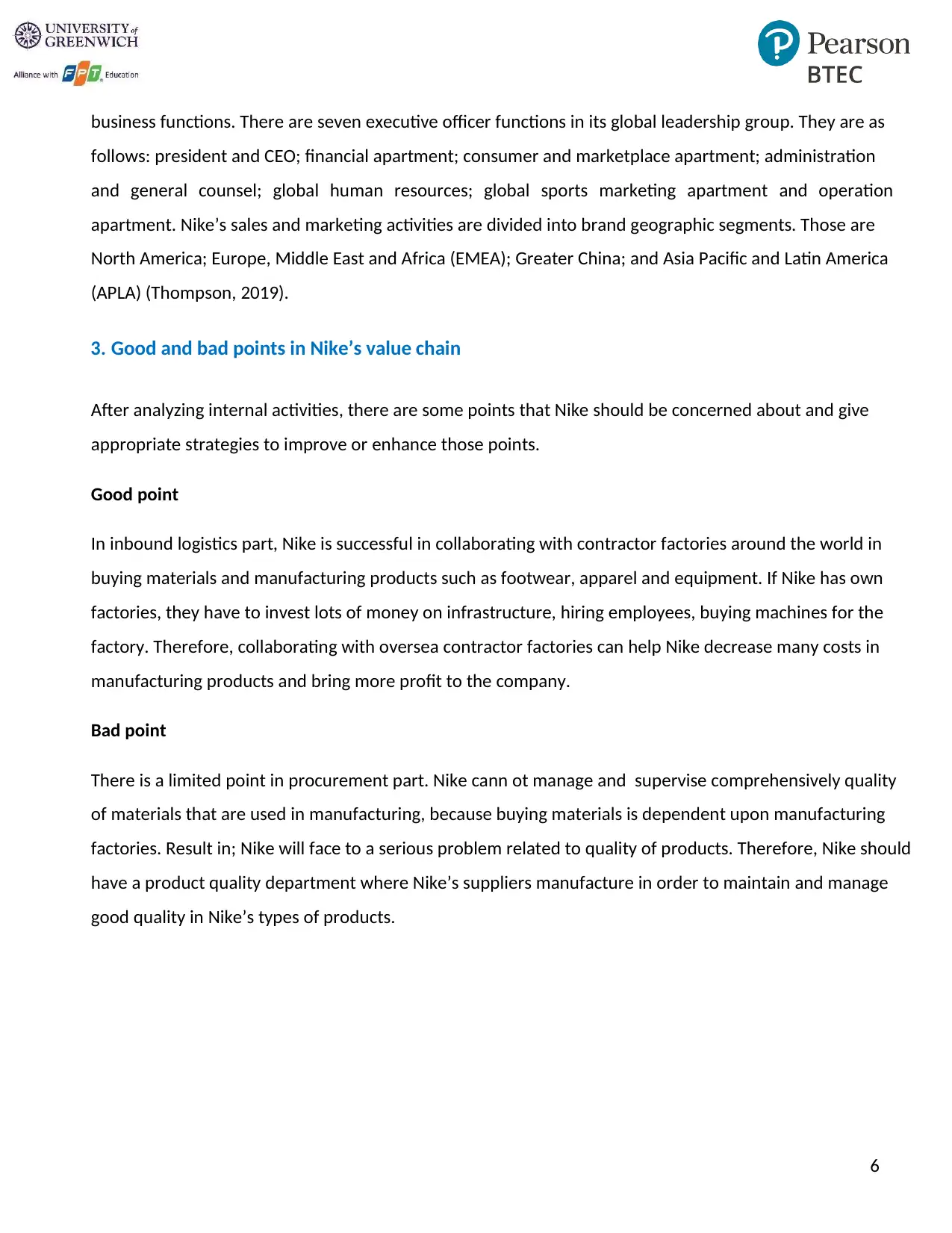
6
business functions. There are seven executive officer functions in its global leadership group. They are as
follows: president and CEO; financial apartment; consumer and marketplace apartment; administration
and general counsel; global human resources; global sports marketing apartment and operation
apartment. Nike’s sales and marketing activities are divided into brand geographic segments. Those are
North America; Europe, Middle East and Africa (EMEA); Greater China; and Asia Pacific and Latin America
(APLA) (Thompson, 2019).
3. Good and bad points in Nike’s value chain
After analyzing internal activities, there are some points that Nike should be concerned about and give
appropriate strategies to improve or enhance those points.
Good point
In inbound logistics part, Nike is successful in collaborating with contractor factories around the world in
buying materials and manufacturing products such as footwear, apparel and equipment. If Nike has own
factories, they have to invest lots of money on infrastructure, hiring employees, buying machines for the
factory. Therefore, collaborating with oversea contractor factories can help Nike decrease many costs in
manufacturing products and bring more profit to the company.
Bad point
There is a limited point in procurement part. Nike cann ot manage and supervise comprehensively quality
of materials that are used in manufacturing, because buying materials is dependent upon manufacturing
factories. Result in; Nike will face to a serious problem related to quality of products. Therefore, Nike should
have a product quality department where Nike’s suppliers manufacture in order to maintain and manage
good quality in Nike’s types of products.
business functions. There are seven executive officer functions in its global leadership group. They are as
follows: president and CEO; financial apartment; consumer and marketplace apartment; administration
and general counsel; global human resources; global sports marketing apartment and operation
apartment. Nike’s sales and marketing activities are divided into brand geographic segments. Those are
North America; Europe, Middle East and Africa (EMEA); Greater China; and Asia Pacific and Latin America
(APLA) (Thompson, 2019).
3. Good and bad points in Nike’s value chain
After analyzing internal activities, there are some points that Nike should be concerned about and give
appropriate strategies to improve or enhance those points.
Good point
In inbound logistics part, Nike is successful in collaborating with contractor factories around the world in
buying materials and manufacturing products such as footwear, apparel and equipment. If Nike has own
factories, they have to invest lots of money on infrastructure, hiring employees, buying machines for the
factory. Therefore, collaborating with oversea contractor factories can help Nike decrease many costs in
manufacturing products and bring more profit to the company.
Bad point
There is a limited point in procurement part. Nike cann ot manage and supervise comprehensively quality
of materials that are used in manufacturing, because buying materials is dependent upon manufacturing
factories. Result in; Nike will face to a serious problem related to quality of products. Therefore, Nike should
have a product quality department where Nike’s suppliers manufacture in order to maintain and manage
good quality in Nike’s types of products.
Paraphrase This Document
Need a fresh take? Get an instant paraphrase of this document with our AI Paraphraser
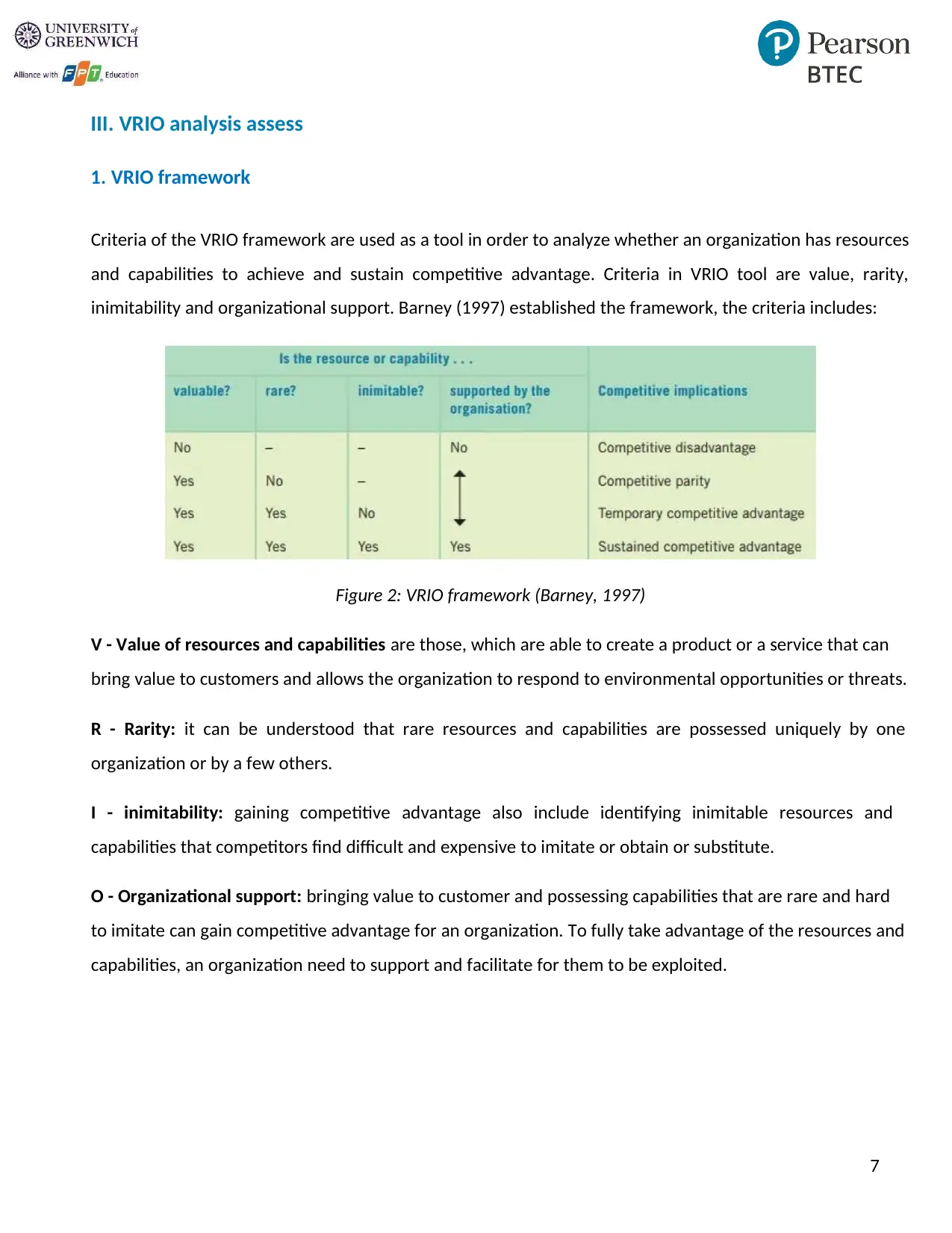
7
III. VRIO analysis assess
1. VRIO framework
Criteria of the VRIO framework are used as a tool in order to analyze whether an organization has resources
and capabilities to achieve and sustain competitive advantage. Criteria in VRIO tool are value, rarity,
inimitability and organizational support. Barney (1997) established the framework, the criteria includes:
Figure 2: VRIO framework (Barney, 1997)
V - Value of resources and capabilities are those, which are able to create a product or a service that can
bring value to customers and allows the organization to respond to environmental opportunities or threats.
R - Rarity: it can be understood that rare resources and capabilities are possessed uniquely by one
organization or by a few others.
I - inimitability: gaining competitive advantage also include identifying inimitable resources and
capabilities that competitors find difficult and expensive to imitate or obtain or substitute.
O - Organizational support: bringing value to customer and possessing capabilities that are rare and hard
to imitate can gain competitive advantage for an organization. To fully take advantage of the resources and
capabilities, an organization need to support and facilitate for them to be exploited.
III. VRIO analysis assess
1. VRIO framework
Criteria of the VRIO framework are used as a tool in order to analyze whether an organization has resources
and capabilities to achieve and sustain competitive advantage. Criteria in VRIO tool are value, rarity,
inimitability and organizational support. Barney (1997) established the framework, the criteria includes:
Figure 2: VRIO framework (Barney, 1997)
V - Value of resources and capabilities are those, which are able to create a product or a service that can
bring value to customers and allows the organization to respond to environmental opportunities or threats.
R - Rarity: it can be understood that rare resources and capabilities are possessed uniquely by one
organization or by a few others.
I - inimitability: gaining competitive advantage also include identifying inimitable resources and
capabilities that competitors find difficult and expensive to imitate or obtain or substitute.
O - Organizational support: bringing value to customer and possessing capabilities that are rare and hard
to imitate can gain competitive advantage for an organization. To fully take advantage of the resources and
capabilities, an organization need to support and facilitate for them to be exploited.
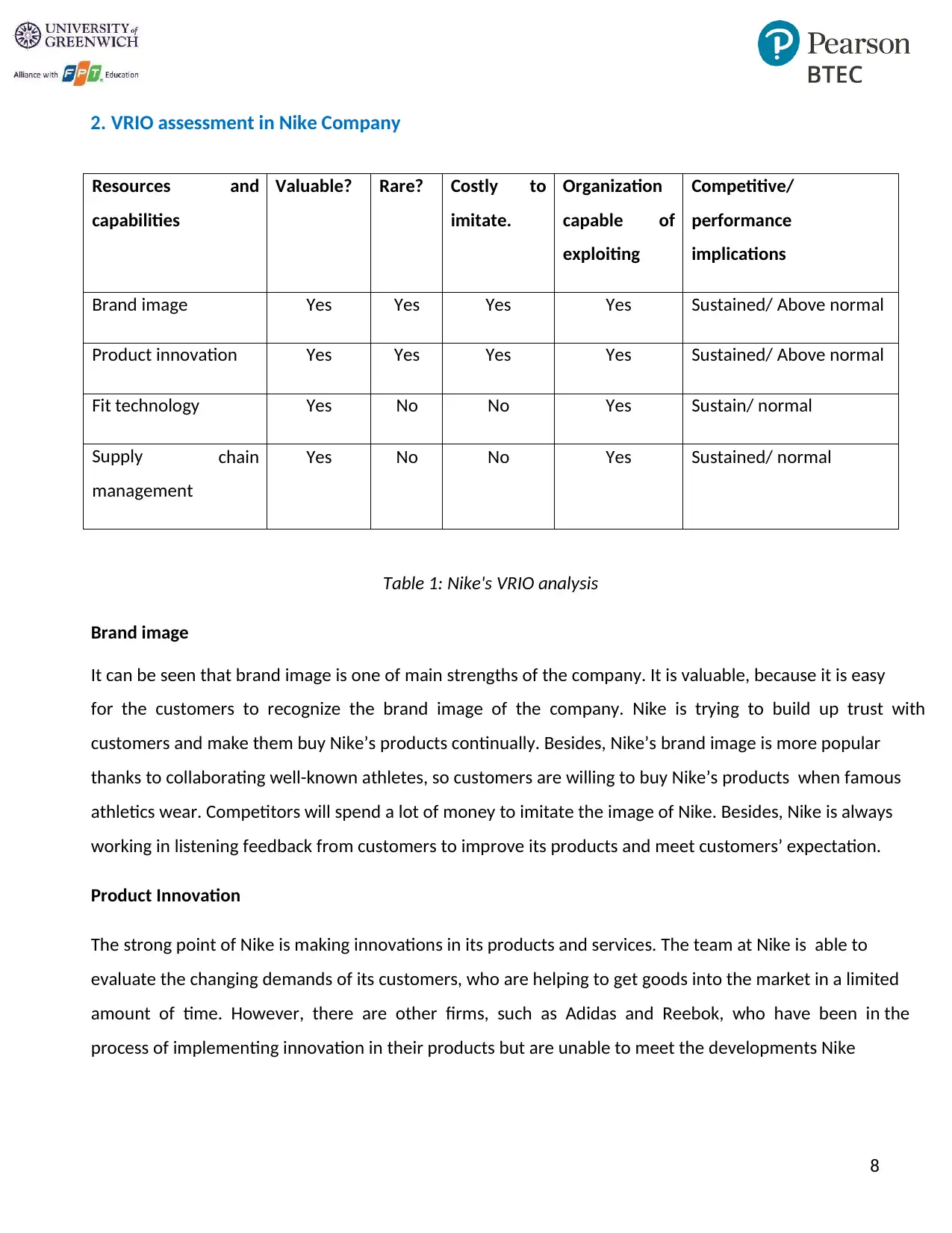
8
2. VRIO assessment in Nike Company
Resources
capabilities
and Valuable? Rare? Costly
imitate.
to Organization
capable of
exploiting
Competitive/
performance
implications
Brand image Yes Yes Yes Yes Sustained/ Above normal
Product innovation Yes Yes Yes Yes Sustained/ Above normal
Fit technology Yes No No Yes Sustain/ normal
Supply
management
chain Yes No No Yes Sustained/ normal
Table 1: Nike's VRIO analysis
Brand image
It can be seen that brand image is one of main strengths of the company. It is valuable, because it is easy
for the customers to recognize the brand image of the company. Nike is trying to build up trust with
customers and make them buy Nike’s products continually. Besides, Nike’s brand image is more popular
thanks to collaborating well-known athletes, so customers are willing to buy Nike’s products when famous
athletics wear. Competitors will spend a lot of money to imitate the image of Nike. Besides, Nike is always
working in listening feedback from customers to improve its products and meet customers’ expectation.
Product Innovation
The strong point of Nike is making innovations in its products and services. The team at Nike is able to
evaluate the changing demands of its customers, who are helping to get goods into the market in a limited
amount of time. However, there are other firms, such as Adidas and Reebok, who have been in the
process of implementing innovation in their products but are unable to meet the developments Nike
2. VRIO assessment in Nike Company
Resources
capabilities
and Valuable? Rare? Costly
imitate.
to Organization
capable of
exploiting
Competitive/
performance
implications
Brand image Yes Yes Yes Yes Sustained/ Above normal
Product innovation Yes Yes Yes Yes Sustained/ Above normal
Fit technology Yes No No Yes Sustain/ normal
Supply
management
chain Yes No No Yes Sustained/ normal
Table 1: Nike's VRIO analysis
Brand image
It can be seen that brand image is one of main strengths of the company. It is valuable, because it is easy
for the customers to recognize the brand image of the company. Nike is trying to build up trust with
customers and make them buy Nike’s products continually. Besides, Nike’s brand image is more popular
thanks to collaborating well-known athletes, so customers are willing to buy Nike’s products when famous
athletics wear. Competitors will spend a lot of money to imitate the image of Nike. Besides, Nike is always
working in listening feedback from customers to improve its products and meet customers’ expectation.
Product Innovation
The strong point of Nike is making innovations in its products and services. The team at Nike is able to
evaluate the changing demands of its customers, who are helping to get goods into the market in a limited
amount of time. However, there are other firms, such as Adidas and Reebok, who have been in the
process of implementing innovation in their products but are unable to meet the developments Nike
⊘ This is a preview!⊘
Do you want full access?
Subscribe today to unlock all pages.

Trusted by 1+ million students worldwide
1 out of 18
Related Documents
Your All-in-One AI-Powered Toolkit for Academic Success.
+13062052269
info@desklib.com
Available 24*7 on WhatsApp / Email
![[object Object]](/_next/static/media/star-bottom.7253800d.svg)
Unlock your academic potential
Copyright © 2020–2025 A2Z Services. All Rights Reserved. Developed and managed by ZUCOL.





